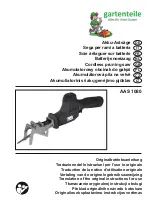
4. Installation And Adjustment
4.1. MAIN BLADE INSTALLATION AND ADJUSTMENT
CAUTION:
Handle the tools with protective gloves.
Disconnect input power.
Position the saw assembly at 90º and raise it as high as possible.
Position the squaring frame (A, Fig.21) as shown in the figure and move the
sliding beam (H, Fig.21) completely to the right and loosen the screws (M,
Fig.21).
Move the sliding beam H completely to the left and loosen the rest of the
screws (M, Fig.22) and open the guard (N, Fig.22); opening activates a
microswitch which prevents the motor from starting.
Fit pin (B, Fig.23) into the saw shaft pulley hole.
NOTICE:
The locking nut (C, Fig.23) of the saw blade is counter-clockwise; to
unscrew it turn it clockwise.
Loosen the lock nut (C, Fig.23) using a 18 mm hex wrench and remove flange (D,
Fig.23).
In sequence mount the blade (E, Fig.23) the flange (D, Fig.23) and the nut (C,
Fig.23) to prevent any vibration, thoroughly clean the flanges before mounting
the saw blade.
Tighten the nut using the 18 mm wrench and the pin (B, Fig.23).
Adjust riving knife (F, Fig.24) height by loosening the nut (G, Fig.24).
CAUTION:
Adjust the position of the riving knife so that its distance from
the saw blade is between 3 and 8 mm. The riving knife is in the right position
when the saw guard covers a part of the cutting edge of the saw blade.
F
Fig.21
Fig.22
Fig.23
Fig.24
M
A
H
M
N
C
E
D
B
G
F
Summary of Contents for TS315
Page 31: ...30 31 ...
















































